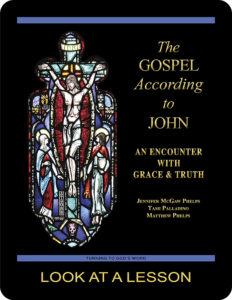I AM the resurrection & the life
 The eleventh chapter of the Gospel According to John (NABRE) contains the account of the raising of Lazarus from the dead. This event serves as the culmination of the signs Jesus performs in the Fourth Gospel, and it serves as a foreshadowing of Jesus’ own Resurrection. The Gospel According to John 11:25 (NABRE)—”Jesus told her, “I am the resurrection and the life; whoever believes in me, even if he dies, will live”—contains one of Jesus’ I AM statements, which tell us something about the divine nature of Jesus Christ.
The eleventh chapter of the Gospel According to John (NABRE) contains the account of the raising of Lazarus from the dead. This event serves as the culmination of the signs Jesus performs in the Fourth Gospel, and it serves as a foreshadowing of Jesus’ own Resurrection. The Gospel According to John 11:25 (NABRE)—”Jesus told her, “I am the resurrection and the life; whoever believes in me, even if he dies, will live”—contains one of Jesus’ I AM statements, which tell us something about the divine nature of Jesus Christ.
On the surface, this I AM statement seems redundant because Jesus mentions both Resurrection and life, but Jesus actually is describing two fundamentally different though related things. The Greek word translated as “resurrection,” ἀνάστασις (anastasis), literally means a raising or a standing up. It describes a physical characteristic of the body of being standing rather than prone, and in that sense, resurrection is something that happens to the physical body. By contrast, ζωή (zoa), the word translated as “life,” describes a more abstract and fundamental state of living or being alive.
Jesus is suggesting that life is not entirely determined by our bodies. Our life depends not on our body but on our soul, and though the body may be dead, the soul nonetheless can live on. While we’ve had 2,000 years to adjust to this radical concept, it’s worth reflecting on how truly extraordinary the notion is that we can live even after our bodies have decayed and passed on. Moreover, Jesus tells us he also has the ability to raise the body, and he promises that on the last day even our bodies will be raised.
you also may like our study of the Gospel According to John
 The Gospel According to John: An Encounter with Grace & Truth, a 25-lesson Catholic Bible study with an imprimatur, examines the Fourth Gospel’s view of Jesus Christ as the Son of God, with special emphasis on the institution of the sacraments of the Church as the means by which Christians are purified and made holy. This recently revised study includes maps and additional commentary, and takes a closer look at the way in which Jesus relates to individual men and women. Click on the book’s cover to view a sample lesson.
The Gospel According to John: An Encounter with Grace & Truth, a 25-lesson Catholic Bible study with an imprimatur, examines the Fourth Gospel’s view of Jesus Christ as the Son of God, with special emphasis on the institution of the sacraments of the Church as the means by which Christians are purified and made holy. This recently revised study includes maps and additional commentary, and takes a closer look at the way in which Jesus relates to individual men and women. Click on the book’s cover to view a sample lesson.
 Click on the picture of the statue of Moses with horns (above) to learn more about Lost in Translation. A new entry is archived each Monday. Contact us to receive Lost in Translation by email every week. You may use any of the contact links on our website to ask Matthew a question.
Click on the picture of the statue of Moses with horns (above) to learn more about Lost in Translation. A new entry is archived each Monday. Contact us to receive Lost in Translation by email every week. You may use any of the contact links on our website to ask Matthew a question.
